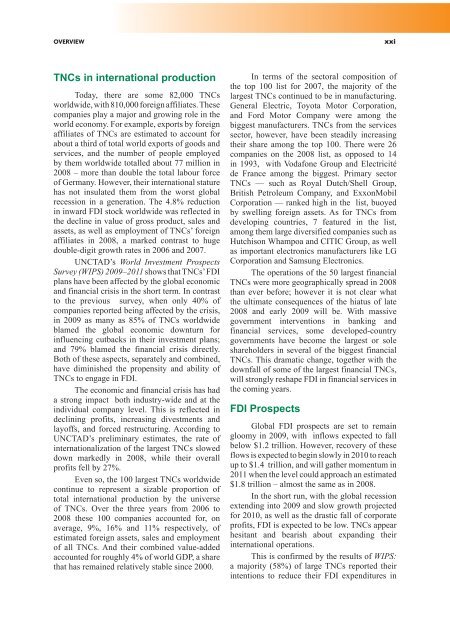World Investment Report 2009: Transnational Corporations - Unctad
World Investment Report 2009: Transnational Corporations - Unctad
World Investment Report 2009: Transnational Corporations - Unctad
You also want an ePaper? Increase the reach of your titles
YUMPU automatically turns print PDFs into web optimized ePapers that Google loves.
OVERVIEW xxi<br />
TNCs in international production<br />
Today, there are some 82,000 TNCs<br />
worldwide, with 810,000 foreign affiliates. These<br />
companies play a major and growing role in the<br />
world economy. For example, exports by foreign<br />
affiliates of TNCs are estimated to account for<br />
about a third of total world exports of goods and<br />
services, and the number of people employed<br />
by them worldwide totalled about 77 million in<br />
2008 – more than double the total labour force<br />
of Germany. However, their international stature<br />
has not insulated them from the worst global<br />
recession in a generation. The 4.8% reduction<br />
in inward FDI stock worldwide was reflected in<br />
the decline in value of gross product, sales and<br />
assets, as well as employment of TNCs’ foreign<br />
affiliates in 2008, a marked contrast to huge<br />
double-digit growth rates in 2006 and 2007.<br />
UNCTAD’s <strong>World</strong> <strong>Investment</strong> Prospects<br />
Survey (WIPS) <strong>2009</strong>–2011 shows that TNCs’ FDI<br />
plans have been affected by the global economic<br />
and financial crisis in the short term. In contrast<br />
to the previous survey, when only 40% of<br />
companies reported being affected by the crisis,<br />
in <strong>2009</strong> as many as 85% of TNCs worldwide<br />
blamed the global economic downturn for<br />
influencing cutbacks in their investment plans;<br />
and 79% blamed the financial crisis directly.<br />
Both of these aspects, separately and combined,<br />
have diminished the propensity and ability of<br />
TNCs to engage in FDI.<br />
The economic and financial crisis has had<br />
a strong impact both industry-wide and at the<br />
individual company level. This is reflected in<br />
declining profits, increasing divestments and<br />
layoffs, and forced restructuring. According to<br />
UNCTAD’s preliminary estimates, the rate of<br />
internationalization of the largest TNCs slowed<br />
down markedly in 2008, while their overall<br />
profits fell by 27%.<br />
Even so, the 100 largest TNCs worldwide<br />
continue to represent a sizable proportion of<br />
total international production by the universe<br />
of TNCs. Over the three years from 2006 to<br />
2008 these 100 companies accounted for, on<br />
average, 9%, 16% and 11% respectively, of<br />
estimated foreign assets, sales and employment<br />
of all TNCs. And their combined value-added<br />
accounted for roughly 4% of world GDP, a share<br />
that has remained relatively stable since 2000.<br />
In terms of the sectoral composition of<br />
the top 100 list for 2007, the majority of the<br />
largest TNCs continued to be in manufacturing.<br />
General Electric, Toyota Motor Corporation,<br />
and Ford Motor Company were among the<br />
biggest manufacturers. TNCs from the services<br />
sector, however, have been steadily increasing<br />
their share among the top 100. There were 26<br />
companies on the 2008 list, as opposed to 14<br />
in 1993, with Vodafone Group and Electricité<br />
de France among the biggest. Primary sector<br />
TNCs — such as Royal Dutch/Shell Group,<br />
British Petroleum Company, and ExxonMobil<br />
Corporation — ranked high in the list, buoyed<br />
by swelling foreign assets. As for TNCs from<br />
developing countries, 7 featured in the list,<br />
among them large diversified companies such as<br />
Hutchison Whampoa and CITIC Group, as well<br />
as important electronics manufacturers like LG<br />
Corporation and Samsung Electronics.<br />
The operations of the 50 largest financial<br />
TNCs were more geographically spread in 2008<br />
than ever before; however it is not clear what<br />
the ultimate consequences of the hiatus of late<br />
2008 and early <strong>2009</strong> will be. With massive<br />
government interventions in banking and<br />
financial services, some developed-country<br />
governments have become the largest or sole<br />
shareholders in several of the biggest financial<br />
TNCs. This dramatic change, together with the<br />
downfall of some of the largest financial TNCs,<br />
will strongly reshape FDI in financial services in<br />
the coming years.<br />
FDI Prospects<br />
Global FDI prospects are set to remain<br />
gloomy in <strong>2009</strong>, with inflows expected to fall<br />
below $1.2 trillion. However, recovery of these<br />
flows is expected to begin slowly in 2010 to reach<br />
up to $1.4 trillion, and will gather momentum in<br />
2011 when the level could approach an estimated<br />
$1.8 trillion – almost the same as in 2008.<br />
In the short run, with the global recession<br />
extending into <strong>2009</strong> and slow growth projected<br />
for 2010, as well as the drastic fall of corporate<br />
profits, FDI is expected to be low. TNCs appear<br />
hesitant and bearish about expanding their<br />
international operations.<br />
This is confirmed by the results of WIPS:<br />
a majority (58%) of large TNCs reported their<br />
intentions to reduce their FDI expenditures in

















